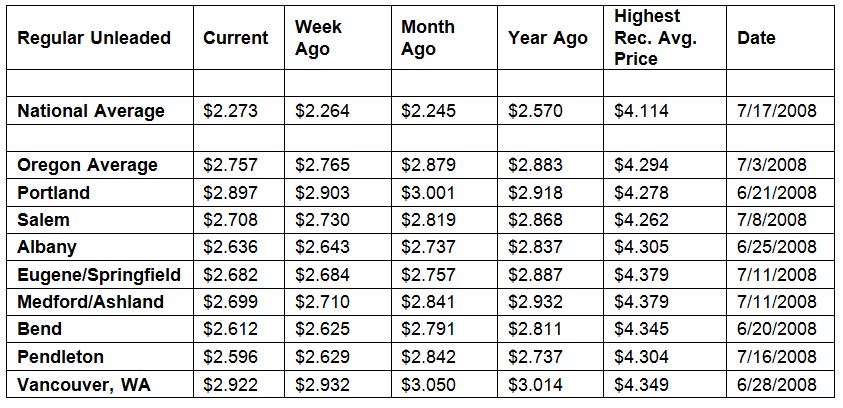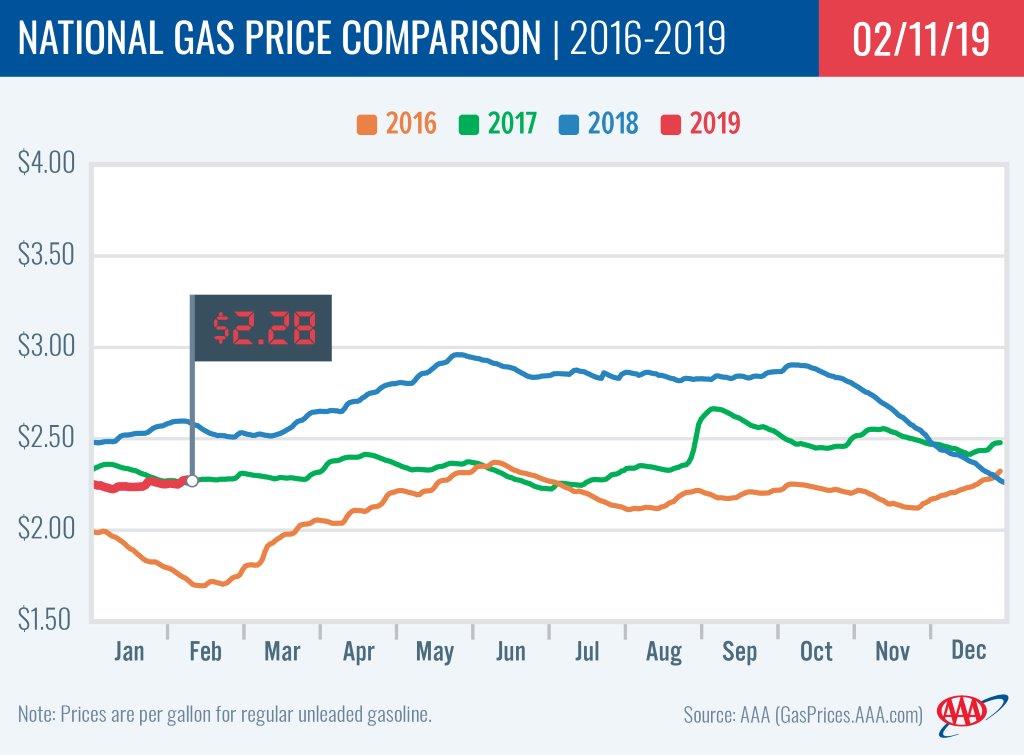Eight states see pump prices climb by a nickel or more
PORTLAND, Ore., – A drop in demand for gasoline, along with planned and unplanned maintenance at refineries are impacting retail gasoline prices. Some states are seeing prices rise or fall by a nickel or more while prices in other states, including Oregon, are relatively flat. For the week, the national average adds a penny to $2.27 a gallon while the Oregon average slips a penny to $2.76. The Oregon average is at its lowest price since November 2017.
Cold temperatures and wintry weather across much of the country have contributed toward a half a million barrel per day drop in demand to measure at 9 million bbl – a level consistent with a year ago according to the U.S. Energy Information Administration (EIA). At the same time, gasoline stocks saw a nominal 513,000 bbl increase for a total of 257.8 bbl. While demand is mostly flat year-over-year, total stocks sit at a 124 million bbl surplus.
“Crude oil prices are lower than a year ago, moving between around $51 and $55 dollars per barrel since the start of the year. Gasoline stocks are fluctuating, due to planned and unplanned maintenance at U.S. refineries. And demand has fluctuated this winter, due to extreme weather hitting much of the country. All of these factors are causing pump prices to move up and down,” says Marie Dodds, public affairs director for AAA Oregon/Idaho.
Oregon is one of 22 states and the District of Columbia where gas prices are lower week-over-week. Utah (-6 cents) has the largest drop. Missouri (+8 cents) has the largest weekly increase. This week two states, California and Hawaii, have averages at or above $3 a gallon, same as a week ago.
Oregon is one of 24 states and the District of Columbia with lower prices now than a month ago. The national average is three cents less and the Oregon average is 12 cents less than a month ago. This is the seventh-largest monthly drop in the nation. Utah (-24 cents) has the largest monthly decrease. Illinois (+16 cents) has the largest month-over-month increase.
The West Coast continues to have the most expensive gas prices in the nation with all of the region’s states landing on the top 10 most expensive list. California and Hawaii are the most expensive states, with Washington, Nevada, Alaska and Oregon rounding out the top six. Oregon is sixth most expensive for the sixth week in a row. Prices have seen some movement in this region this week, with Alaska (-4 cents) seeing the largest drop and California (+2 cents) seeing the largest increase.
| Rank | Region | Price on 2/12/19 | |
| 1 | California | $3.27 | |
| 2 | Hawaii | $3.27 | |
| 3 | Washington | $2.88 | |
| 4 | Nevada | $2.85 | |
| 5 | Alaska | $2.84 | |
| 6 | Oregon | $2.76 | |
| 7 | District of Columbia | $2.52 | |
| 8 | Pennsylvania | $2.49 | |
| 9 | New York | $2.47 | |
| 10 | Connecticut | $2.45 |
EIA’s recent weekly report shows that West Coast gasoline stocks decreased slightly by approximately 200,000 bbl to 32.6 million bbl. Stocks are approximately 2.4 million bbl lower than at this time last year, which could cause prices to spike if there is a supply challenge in the region this week.
The nation’s cheapest markets are Arkansas ($1.97) and Mississippi ($1.97). In all, six states have averages below $2 a gallon this week down from nine states a week ago.
Oregon is one of 48 states and the District of Columbia where drivers are paying less than a year ago to fill up. The national average is 30 cents less and the Oregon average is 13 cents less than a year ago. Iowa (-47 cents) has the greatest year-over-year decrease; Nevada (+6 cents) and Arizona (+6 cents) are the only two states with year-over-year increases.
Oil Market Dynamics
Oil prices were volatile last week and that trend continues this week. The latest data from EIA that showed that at the end of the previous week, total domestic crude oil inventories rose less than expected – a build of only 1.3 million bbl to total 447.2 million bbl. For market observers, the price gains indicate that the global crude supply is tightening, an anticipated result of U.S.-imposed sanctions on Iran’s crude exports and OPEC’s production reduction agreement of 1.2 million b/d with other non-OPEC producers, including Russia. The reduction agreement remains in effect for the first six months of 2019.
Additionally, the global crude supply is expected to shrink as a result of U.S.-imposed sanctions on crude exports from Venezuela, which could send crude prices higher. Market watchers this week are also watching for indications that the trade tensions between China and the U.S. are heading toward resolution, reducing fears of lowered crude demand as a result of continued escalation of the dispute.
In related news, Baker Hughes Inc. reported that the U.S. added seven oil rigs last week, bringing the total to 854. When compared to last year at this time, there are 63 more rigs this year.
At the close of Friday’s formal trading session on the NYMEX, WTI increased eight cents to settle at $52.72. At the close of Monday’s formal trading session on the NYMEX, WTI lost 31 cents to settle at $52.41. Today crude is trading around $54, same as a week ago. Crude prices are up about five percent in the last month and are about $7 per barrel lower than a year ago.
Drivers can find current gas prices along their route with the free AAA Mobile app for iPhone, iPad and Android. The app can also be used to map a route, find discounts, book a hotel and access AAA roadside assistance. Learn more at AAA.com/mobile.
Diesel
For the week, the national average is flat at $2.92 a gallon. Oregon’s average slips a penny to $3.05. A year ago the national average for diesel was $2.99 and the Oregon average was $3.09.
Find current fuel prices at GasPrices.AAA.com.
AAA news releases, high resolution images, broadcast-quality video, fact sheets and podcasts are available on the AAA NewsRoom at NewsRoom.AAA.com.
Fuel prices are updated daily at AAA’s Daily Fuel Gauge at AAA Gas Prices. For more info go www.AAA.com. AAA Oregon/Idaho provides more than 800,000 members with travel, insurance, financial and automotive-related services, and is an affiliate of AAA National, serving more than 59 million motorists in North America.



